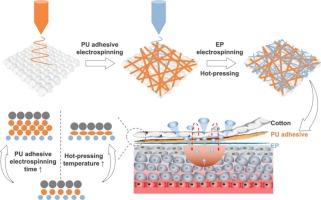A trilayered composite membrane with a pore-tunable interlayer for liquid management in wound dressing applications
IF 5.1
3区 工程技术
Q1 CHEMISTRY, APPLIED
引用次数: 0
Abstract
Effective wound dressings must simultaneously drain excess exudate and maintain a moist microenvironment; however, facile fabrication of dressings enabling such bidirectional fluid management remains challenging. Herein, we report a structurally robust trilayered composite membrane engineered via sequential electrospinning and hot-pressing, featuring a pore-tunable interlayer for precise liquid manipulation. The hierarchical architecture comprises a hydrophilic cotton layer, an electrospun polyurethane (PU) adhesive interlayer, and a hydrophobic PU/ethylcellulose (EP) layer, where the interlayer serves as the critical regulator of liquid behavior. By tuning the porosity to range from 36.3 % to less than 1 % through controlling the electrospinning duration of the PU adhesive layer (30–90 min) and hot-pressing temperature (60–80 °C), we achieved synergistic bidirectional fluid control: efficient exudate drainage performance coupled with controllable backflow propensity. Specifically, the water droplets penetrated from the hydrophobic to the hydrophilic side within 7 s, and additionally, larger porosity correlated with enhanced backflow, thereby achieving balanced moisture retention. Systematic in vitro investigations revealed correlations between fabrication parameters and the membrane's morphological, wettability, air permeability (73.0 to 3.3 mm/s), and liquid management properties. Moreover, the trilayered composite membrane possessed great cytocompatibility (approximately 99 %) and maintained skin humidity above 44 %. This work presents a straightforward strategy for designing functional polymer composites with tunable bidirectional fluid transport, highlighting the trilayered membrane's promising application potential in advanced wound care based on in vitro evaluations.

一种具有孔可调中间层的三层复合膜,用于伤口敷料应用中的液体管理
有效的伤口敷料必须同时排出多余的渗出液并保持湿润的微环境;然而,实现这种双向流体管理的敷料的简单制造仍然具有挑战性。在此,我们报告了一种结构坚固的三层复合膜,通过连续静电纺丝和热压工程,具有孔径可调的中间层,用于精确的液体操作。分层结构包括亲水性棉层,静电纺聚氨酯(PU)粘合剂中间层和疏水性PU/乙基纤维素(EP)层,其中中间层作为液体行为的关键调节剂。通过控制PU粘接层的静电纺丝时间(30-90分钟)和热压温度(60-80°C),将孔隙率调整到36.3%至小于1%的范围内,我们实现了协同的双向流体控制:高效的排液性能与可控的回流倾向相结合。具体来说,水滴在7 s内从疏水侧渗透到亲水侧,并且孔隙度越大,回流增强,从而实现平衡的保湿。系统的体外研究揭示了制备参数与膜的形态、润湿性、透气性(73.0至3.3 mm/s)和液体管理性能之间的相关性。此外,三层复合膜具有良好的细胞相容性(约99%),并保持皮肤湿度在44%以上。这项工作提出了一种设计具有可调双向流体输送功能的聚合物复合材料的简单策略,强调了基于体外评估的三层膜在高级伤口护理中的应用潜力。
本文章由计算机程序翻译,如有差异,请以英文原文为准。
求助全文
约1分钟内获得全文
求助全文
来源期刊

Reactive & Functional Polymers
工程技术-高分子科学
CiteScore
8.90
自引率
5.90%
发文量
259
审稿时长
27 days
期刊介绍:
Reactive & Functional Polymers provides a forum to disseminate original ideas, concepts and developments in the science and technology of polymers with functional groups, which impart specific chemical reactivity or physical, chemical, structural, biological, and pharmacological functionality. The scope covers organic polymers, acting for instance as reagents, catalysts, templates, ion-exchangers, selective sorbents, chelating or antimicrobial agents, drug carriers, sensors, membranes, and hydrogels. This also includes reactive cross-linkable prepolymers and high-performance thermosetting polymers, natural or degradable polymers, conducting polymers, and porous polymers.
Original research articles must contain thorough molecular and material characterization data on synthesis of the above polymers in combination with their applications. Applications include but are not limited to catalysis, water or effluent treatment, separations and recovery, electronics and information storage, energy conversion, encapsulation, or adhesion.
 求助内容:
求助内容: 应助结果提醒方式:
应助结果提醒方式:


